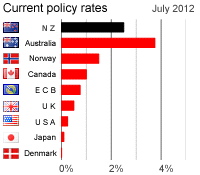 The Reserve Bank of Australia (RBA) has cut its cash rate by 75 basis points to 5.25%, which was more than the 50 basis points that almost all economists had expected. The Reserve Bank held its cards close to its chest about future rate moves, citing opposing forces on inflation from global disinflation and the fall in the Australian dollar.
What I think it means
This reinforces expectations that the Reserve Bank of New Zealand will cut its Official Cash Rate by a further 50 basis points or more on December 4 to 6% or lower.
Term deposit rates are likely to keep dropping so locking in higher and longer term rates now makes sense. See all term deposit rates up to one year here and beyond one year here.
If our OCR falls below 5%, which is no sure thing, then variable mortgage rates start to look more attractive than fixed mortgage rates. This is because high funding costs and the extra costs of the government guarantee on bank debt issuance overseas will make it difficult for the big banks to cut their fixed rates much below 7.5%. That means the 7.5-8% deals on offer right now for 1 year fixed rate mortgages are looking the most attractive at the moment. See all mortgage rates on offer here.
Here's the full Reserve Bank of Australia statement on the rate cut.
The Reserve Bank of Australia (RBA) has cut its cash rate by 75 basis points to 5.25%, which was more than the 50 basis points that almost all economists had expected. The Reserve Bank held its cards close to its chest about future rate moves, citing opposing forces on inflation from global disinflation and the fall in the Australian dollar.
What I think it means
This reinforces expectations that the Reserve Bank of New Zealand will cut its Official Cash Rate by a further 50 basis points or more on December 4 to 6% or lower.
Term deposit rates are likely to keep dropping so locking in higher and longer term rates now makes sense. See all term deposit rates up to one year here and beyond one year here.
If our OCR falls below 5%, which is no sure thing, then variable mortgage rates start to look more attractive than fixed mortgage rates. This is because high funding costs and the extra costs of the government guarantee on bank debt issuance overseas will make it difficult for the big banks to cut their fixed rates much below 7.5%. That means the 7.5-8% deals on offer right now for 1 year fixed rate mortgages are looking the most attractive at the moment. See all mortgage rates on offer here.
Here's the full Reserve Bank of Australia statement on the rate cut.
World financial markets have remained turbulent over the past month. Global equity prices have been volatile and fell further in net terms, and there have been significant exchange rate movements, including a sharp depreciation of the Australian dollar. A number of governments have announced measures to strengthen their financial systems, which should help to stabilise conditions over time. International economic data have continued to point to significant weakness in the major industrial economies, and there have been further signs that China and other parts of the developing world are slowing as well. These conditions have contributed to further falls in world commodity prices. In Australia, the overall path of economic activity appears until recently to have been close to what the Board had expected, with a needed moderation in demand occurring after a period of earlier strength. Recent reductions in borrowing rates, the depreciation of the exchange rate and the fiscal stimulus announced in October will work to assist growth in the period ahead, but deteriorating international conditions and falling commodity prices will have a dampening influence. On balance, it appears likely that spending and activity will be weaker than earlier expected. Consumer price inflation in Australia remained high in the September quarter. As expected, CPI inflation in year"‘ended terms picked up to 5 per cent, while underlying measures were just over 4½ per cent. Nonetheless, capacity pressures are now easing and, given the outlook for more moderate growth in demand and activity, it is reasonable to expect that inflation in Australia will soon start to fall. Global disinflationary forces will assist in this regard, though the depreciation of the exchange rate means that the decline of inflation to the target could take longer than would otherwise be the case. Weighing up these international and domestic developments, the Board judged that a further significant reduction in the cash rate was warranted. The Board will continue to monitor developments and make adjustments as needed to promote sustainable growth consistent with achieving the 2"“3 per cent inflation target over time.

We welcome your comments below. If you are not already registered, please register to comment
Remember we welcome robust, respectful and insightful debate. We don't welcome abusive or defamatory comments and will de-register those repeatedly making such comments. Our current comment policy is here.